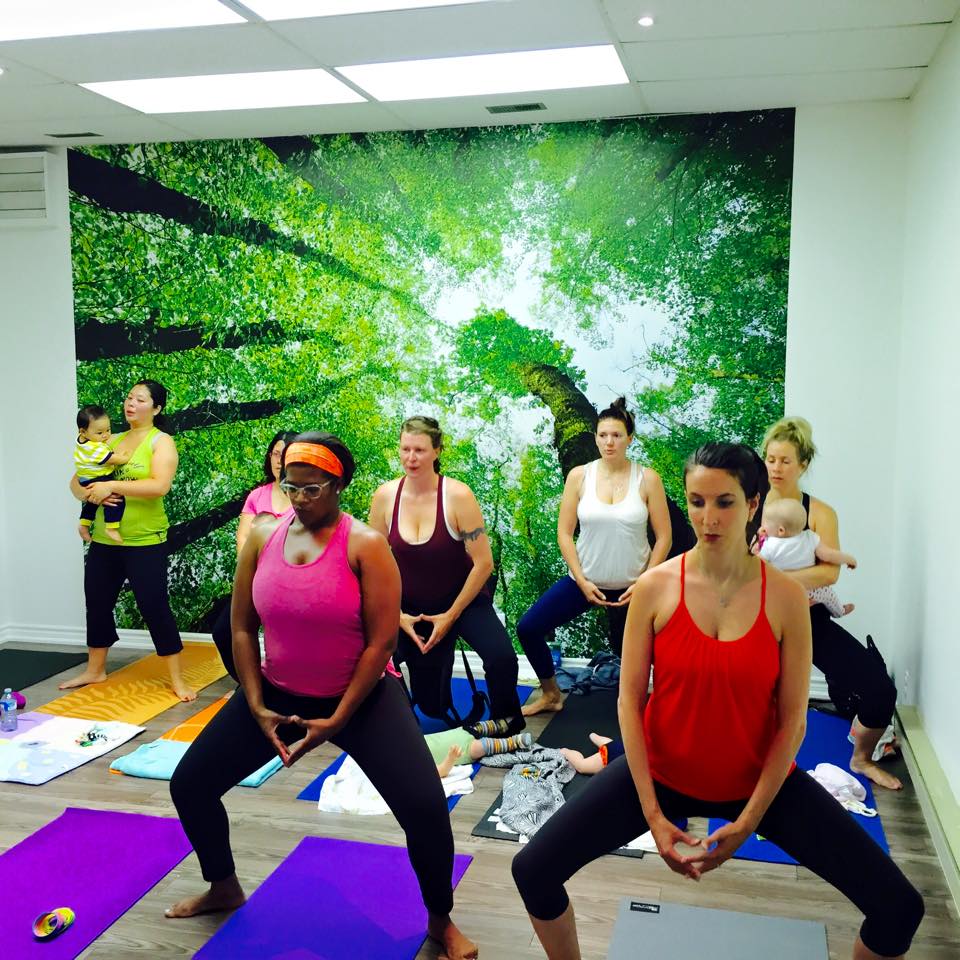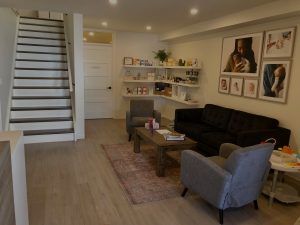As a Pelvic Health Physiotherapist working at a pre and post-natal centred clinic (The WOMB – Milton), I see multiple clients a week navigating through the fourth trimester of pregnancy – the first 3 months AFTER birth (we also see clients throughout pregnancy – I wrote a blog about exercise in pregnancy here). The fourth trimester is a HUGE time of change. You, as a new mom, are learning how to be a Mom – navigating how to eat, sleep and nourish yourself and your new baby (or babies!). During this time, your body is undergoing a huge amount of change as well – your organs are repositioning themselves after giving up most of their space to Baby for 9 months, your abdominal wall is re-tensioning and you may be healing from some stretching or stitches in the abdomen (from a caesarean birth) or pelvic floor (from a vaginal birth). You might have some leaking (incontinence) or maybe some back or pelvic pain. Plus, now you are constantly juggling a floppy newborn Baby – standing, carrying, feeding in seated or lying down (or somewhere in between!), picking up toys, food, disregarded soothers, car seats, strollers, and all on 2-3 hours of sleep…. Phewf! You and your body are going through a lot! Fortunately, the reality is that our bodies are strong, reliable and so dynamic! Here is what you can do to set yourself up for an optimal recovery AFTER Baby.
Phase 1: Week 1-3: Adjusting to Motherhood and Getting Back to Basics
Focus #1 – Baby
Focus #2 – Get some sleep yourself!
Focus #3 – Breathe.
During pregnancy Moms tend to breathe up into the chest because Baby is in the way, preventing full, deep breaths. Your body has learned this pattern over a matter of months and may automatically continue breathing this way unless you give it a little conscious thought. When we are using our diaphragm to breathe our abdomen rises and our ribs move out to the side and our chest is the last thing to move. This breath pattern, called “diaphragmic breathing”, naturally helps the pelvic floor to function optimally and get back on board after Baby.
I often suggest Moms try to fit this in as they feed – this is something you usually do multiple times a day and once Baby is set up you can concentrate on your breath. This is a bonus because this can also be a little mini-meditation and some quiet time to regroup.
Focus #4 – Posture
During pregnancy your weight distribution changed through the pelvis and legs as Baby grew. After pregnancy your body may be used to standing as if you were still pregnant – this is typically with the ribs back and your tailbone tucked under you. Check out an easy way to set up a more neutral posture after baby is born.
Yes, for most new Moms this will feel like you are leaning forward or sticking your booty out like Beyoncé. This is just because your body is used to being shifted back so it thinks being stacking ribs over pelvis is forward. If you keep your weight in the middle of your feet and look in a mirror as you set up your posture like in the video then you will see that you are indeed upright – if your weight is over the toes then yes, you may be leaning too far forward.
Phase 2: Week 4-6+: Returning to Activity
Around this time you might be starting to feel like you are getting into the groove at home, might be going a little stir crazy and/or want to do some exercise. (Or you might still be adjusting to new life with Baby – in which case take your time in Phase 1, no rush!). You might have your appointment with your OB or midwife where they might give you the go ahead to return to activity… with little instruction after that. Does this mean you can jump back in to running, Bootcamp, Body Bump, CrossFit, HITT, 21 Day Fix, etc?
The short answer is, it depends.
Did your OB or midwife look at your birth region (abdomen or pelvis) at your appointment? Maybe. Did they test for strength, relaxation or activation patterns of the ab muscles and pelvic floor? Probably not. Imagine you injure your bicep. Your Doctor’s job is to tell you that you have an injury, stitch you up if needed, make sure you don’t have an injection, maybe give you some meds and refer you to an expert if needed. It is your Physiotherapist’s job to assess the biceps functionally (does it work so you can lift things?) and give you some stretching and strengthening to do to help you recover. This is what Pelvic Health Physios (like me!) do for your abs and pelvic floor (and back and hips, too). We take a look to see if you have Rectus Diastasis (AKA abdominal separation AKA Mummy Tummy), we help address any incontinence (bladder or bowel leaking) issues and ensure you don’t have any prolapse (abdominal organ shifts). We also help educate you about why your might have pain with sexual activity and what you can do about it (and there is a lot we can do about it!) and help you get back to whatever form of activity you want to get back to – whether that is walking, yoga, power lifting, boxing, Crossfit, pole dancing… etc! This might be something you can get back to quickly or it might be something we will work up to as your body continues to change and recover – it really changes person-to-person.
 In general it is wise to start at a lower intensity and build up – for some this may start with short walks outside and build up to jogging, for others this may mean doing modified WODs with lighter weights. Your body is still adjusting to life with Baby on the outside, you might be allocating more body energy to breastfeeding, your hormones are still fluctuating and you are probably running on less sleep than before. Be patient with yourself – “know your limit, play within it”, is a great phrase to remember during the third trimester. My job as a Pelvic Physio is to help you know what your limit is.
In general it is wise to start at a lower intensity and build up – for some this may start with short walks outside and build up to jogging, for others this may mean doing modified WODs with lighter weights. Your body is still adjusting to life with Baby on the outside, you might be allocating more body energy to breastfeeding, your hormones are still fluctuating and you are probably running on less sleep than before. Be patient with yourself – “know your limit, play within it”, is a great phrase to remember during the third trimester. My job as a Pelvic Physio is to help you know what your limit is.
What about sit ups, planks, Russian twists?
Again, it depends. When working well, the inner core (diaphragm, abs and pelvic floor) work to support our outer core (“6 pack” rectus abdominus, the twisting obliques, back muscles, glutes [bum muscles]) through all our movements and tasks. If your inner core is working well then sure, do all of these activities! How do you know when your inner core is working well? In general, your abdomen will automatically flatten not bulge when you do movement (this is not clenching), you will have no leaking, no pressure or heaviness in the pelvis, and no pain. However, you can definitely still have suboptimal inner core function without these symptoms that might creep in over time. One study has shown that women can develop incontinence 5-7 years after birth. Personally, my inner core coordination was off and I didn’t realize until I started running over 5km and then had hip pain. This resolved once I saw a Pelvic Health PT and did some simple rebalancing exercises.
What about CrossFit or HITT?
These forms of exercises are awesome for full body workouts – we definitely want to build you up to returning to these exercises we just have to ensure you’re working from the inside out. Learning how the inner core supports you through these exercises and how to brace for heavy lifts properly will help to prevent any issues from arising from your sport, and usually results in improved PBs (personal best) as well.
Overall, most people can return to their preferred form of exercise safely after birth as long as the inner core is serving you well. How much rehab you will need to build you up to these activities varies from person to person. As Pelvic Health Physios, we help you reconnect with your pelvic floor and inner core muscles to ensure everything is ship shape to support your through lifting and chasing after your kids as well as any other sports or exercises you want to pursue.
If you have any questions, please don’t hesitate to set up an appointment to meet with us at The WOMB or check out our Mummy Tummy workshop.

Jenny Telfer Crum is a pelvic health physiotherapist at The WOMB. She specializes in preparing the body for birth and then helping women return to exercise after pregnancy and has taken advanced courses to help high intensity weekend warriors return to their training of choice.
The WOMB offers Mummy Tummy Workshops, Pfilates classes (pelvic floor pilates), Momma & Baby Core classes and when you’re ready Mommy Bootcamp.





